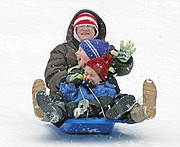U.S. military tracks Santa's progress
The NORAD Tracks Santa program will celebrate its 60th anniversary on Thursday, Dec. 24. Starting at 12:01 a.m. Mountain Standard Time on Christmas Eve, people can call or go online for up-to-date information on Santa’s whereabouts.
The program started when a Colorado Springs, Colo. newspaper ran a special Christmas advertisement from a local Sears department store. The advertisement depicted an illustration of jolly old Saint Nick, along with a phone number and a message that said children could call the number anytime, day or night, and Santa would personally talk to them.
On Dec. 24, 1955, Colonel Harry Shoup of Continental Air Defense Command (CONAD) received a call on a red phone on his desk that only rang in the case of a crisis. As he picked up the phone, he expected terrible news.
Instead, Col. Shoup heard the voice of a child on the other end of the line.
“Is this Santa Claus?” asked the child.
Shoup improvised, impersonating Santa Claus as he spoke, in order to fulfill the child’s desire to speak to the man who would bring their toys.
Throughout the evening, more and more children called CONAD because of the erroneously-printed number, asking to speak to Santa. Col. Shoup ordered his staff to field the calls, and as they did, to impersonate Santa and provide the children with Santa’s current location.
And thus, a new Christmas tradition was born. Since that fateful night when Col. Shoup picked up the phone, the United States’ air defense command has operated a special hotline every Christmas Eve for curious children and their families to call in order to get updates on Santa Claus’ global journey.
In 1958, CONAD was replaced with the North American Aerospace Defense Command (NORAD). Following the change, the program Col. Shoup pioneered became known as the NORAD Tracks Santa program, which NORAD personnel operate from their headquarters at Peterson Air Force Base in Colorado.
NORAD purportedly tracks Santa using satellite systems, high-powered radars and jet fighters as he leaves the North Pole and sets about delivering presents to boys and girls around the world.
From 1955 until 1996, the program operated on telephone hotlines and depended upon newspaper, radio and television advertisements to publicize the event.
The advent of the Internet and the rising popularity of social media brought big changes to the program. Today, the program has an official website complete with a “Santa Tracker” that follows Santa’s movements around the globe. It also provides information about Santa and his home at the North Pole.
According to NORAD’s official website, the thousands of volunteers who staff the phones and computers during the program receive more than 12,000 emails and 70,000 telephone calls from children all around the world who are curious about Santa’s location. The site also reportedly receives nearly nine million unique visitors from more than 200 countries and territories around the world.
The Santa Tracker can be viewed at www.noradsanta.org. There are also apps available to download for mobile devices. In addition to the program’s website and dedicated apps, NORAD’s Twitter, Facebook, Google Plus and YouTube accounts will also have updates on Santa’s trip around the world.



